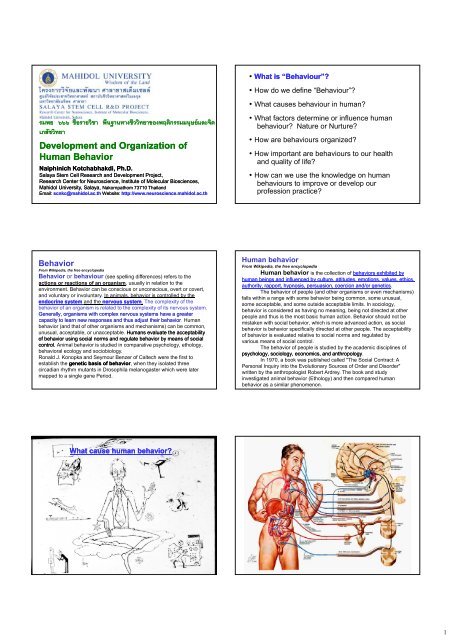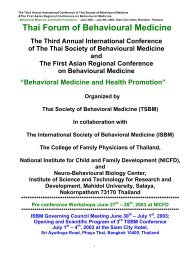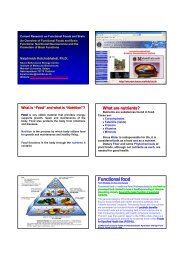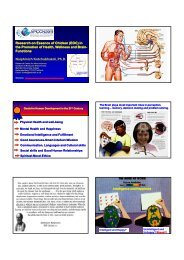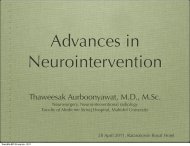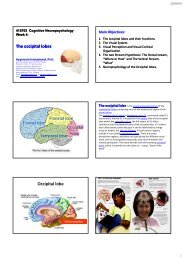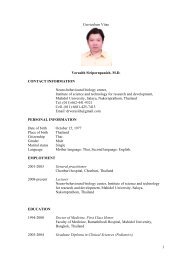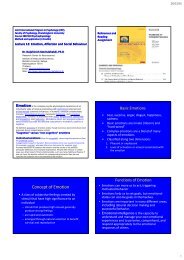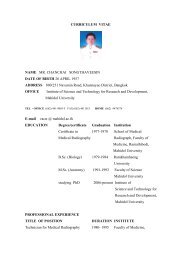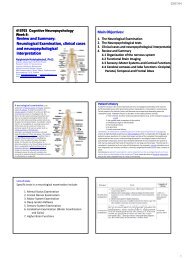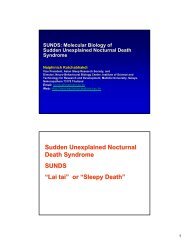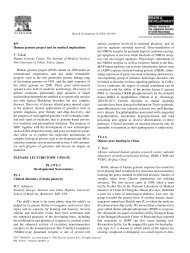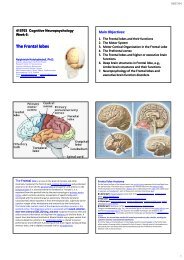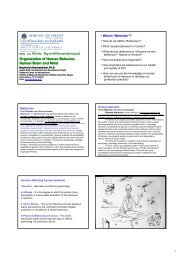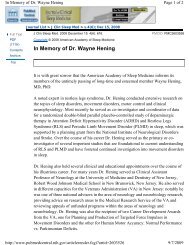1 Development and Organization Development and Organization of ...
1 Development and Organization Development and Organization of ...
1 Development and Organization Development and Organization of ...
You also want an ePaper? Increase the reach of your titles
YUMPU automatically turns print PDFs into web optimized ePapers that Google loves.
• What is “Behaviour”<br />
• How do we define “Behaviour”<br />
• What causes behaviour in human<br />
รมพย ๖๖๖ ชื<br />
่อรายวิชา พื้นฐานทางชีววิทยาของพฤติกรรมมนุษย์และจิต<br />
เภสัชวิทยา<br />
<strong>Development</strong> <strong>and</strong> <strong>Organization</strong> <strong>of</strong><br />
Human Behavior<br />
Naiphinich Kotchabhakdi, Ph.D.<br />
Salaya Stem Cell Research <strong>and</strong> <strong>Development</strong> Project,<br />
Research Center for Neuroscience, Institute <strong>of</strong> Molecular Biosciences,<br />
Mahidol University, Salaya, Nakornpathom 73710 Thail<strong>and</strong><br />
Email: scnkc@mahidol.ac.th Website: http://www.neuroscience.mahidol.ac.th<br />
• What factors determine or influence human<br />
behaviour Nature or Nurture<br />
• How are behaviours organized<br />
• How important are behaviours to our health<br />
<strong>and</strong> quality <strong>of</strong> life<br />
• How can we use the knowledge on human<br />
behaviours to improve or develop our<br />
pr<strong>of</strong>ession practice<br />
Behavior<br />
From Wikipedia, the free encyclopedia<br />
Behavior or behaviour (see spelling differences) refers to the<br />
actions or reactions <strong>of</strong> an organism, usually in relation to the<br />
environment. Behavior can be conscious or unconscious, overt or covert,<br />
<strong>and</strong> voluntary or involuntary. In animals, behavior is controlled by the<br />
endocrine system <strong>and</strong> the nervous system. The complexity <strong>of</strong> the<br />
behavior <strong>of</strong> an organism is related to the complexity <strong>of</strong> its nervous system.<br />
Generally, organisms with complex nervous systems have a greater<br />
capacity to learn new responses <strong>and</strong> thus adjust their behavior. Human<br />
behavior (<strong>and</strong> that <strong>of</strong> other organisms <strong>and</strong> mechanisms) can be common,<br />
unusual, acceptable, or unacceptable. Humans evaluate the acceptability<br />
<strong>of</strong> behavior using social norms <strong>and</strong> regulate behavior by means <strong>of</strong> social<br />
control. Animal behavior is studied in comparative psychology, ethology,<br />
behavioral ecology <strong>and</strong> sociobiology.<br />
Ronald J. Konopka <strong>and</strong> Seymour Benzer <strong>of</strong> Caltech were the first to<br />
establish the genetic basis <strong>of</strong> behavior, when they isolated three<br />
circadian rhythm mutants in Drosophila melanogaster which were later<br />
mapped to a single gene Period.<br />
Human behavior<br />
From Wikipedia, the free encyclopedia<br />
Human behavior is the collection <strong>of</strong> behaviors<br />
behaviors exhibited by<br />
human beings <strong>and</strong> influenced by culture, attitudes, emotions, values, ethics,<br />
authority, rapport, hypnosis, persuasion, coercion <strong>and</strong>/or<br />
genetics.<br />
The behavior <strong>of</strong> people (<strong>and</strong> other organisms or even mechanisms)<br />
falls within a range with some behavior being common, some unusual,<br />
some acceptable, <strong>and</strong> some outside acceptable limits. In sociology,<br />
behavior is considered as having no meaning, being not directed at other<br />
people <strong>and</strong> thus is the most basic human action. Behavior should not be<br />
mistaken with social behavior, which is more advanced action, as social<br />
behavior is behavior specifically directed at other people. The acceptability<br />
<strong>of</strong> behavior is evaluated relative to social norms <strong>and</strong> regulated by<br />
various means <strong>of</strong> social control.<br />
The behavior <strong>of</strong> people is studied by the academic disciplines <strong>of</strong><br />
psychology, sociology, economics, <strong>and</strong> anthropology.<br />
In 1970, a book was published called "The Social Contract: A<br />
Personal Inquiry into the Evolutionary Sources <strong>of</strong> Order <strong>and</strong> Disorder"<br />
written by the anthropologist Robert Ardrey. The book <strong>and</strong> study<br />
investigated animal behavior (Ethology) <strong>and</strong> then compared human<br />
behavior as a similar phenomenon.<br />
What cause human behavior<br />
1
Hierarchy <strong>of</strong><br />
Problems<br />
<strong>and</strong><br />
Consideration<br />
Sites <strong>and</strong><br />
Mechanisms<br />
<strong>of</strong> ff<br />
function<br />
Utilization<br />
<strong>of</strong> Knowledge<br />
<strong>and</strong><br />
Wisdom<br />
Factors affecting human behavior<br />
● Genetics - from genes to proteins to behaviors.<br />
● Brain (Nervous system) – control behaviors.<br />
● Attitude – It is the degree to which the person has a<br />
favourable or unfavourable evaluation <strong>of</strong> the behaviour<br />
in question.<br />
● Social Norms – This is the influence <strong>of</strong> social pressure<br />
that is perceived by the individual (normative beliefs)<br />
to perform or not perform a certain behaviour.<br />
● Perceived Behavioural Control – This is the<br />
individual’s belief concerning how easy or difficult<br />
performing the behaviour will be.<br />
2
Sleep<br />
Unable to sleep: Insomnia<br />
Post-traumatic traumatic stress Disorders: PTSD<br />
9-11<br />
Terrorist Attack<br />
3
Fetal response to stress<br />
Family conflicts, aggression <strong>and</strong> violence<br />
4
You might want to know about a human behavior<br />
such as aggression or violence or you might want to<br />
know about human personality traits such as shyness or<br />
introversion/extraversion.<br />
extraversion. You might ask questions such as<br />
" what factors contribute to acts <strong>of</strong> aggression", "does<br />
observing violence on TV influence aggression in children",<br />
"are personality traits stable over time", <strong>and</strong> so forth.<br />
As a clinical psychologists or psychiatric nurses you<br />
might focus in on questions such as " what are the brain<br />
sites which are active during emotions such as anger <strong>and</strong><br />
behaviors which are violent " , " are there particular<br />
chemicals or neurotransmitters which are involved in<br />
aggression", "is the observed sex difference in violence due<br />
to hormones or brain structure", <strong>and</strong> "are there differences in<br />
the brains <strong>of</strong> children who are behaviorally inhibited compared<br />
to those who are outgoing"<br />
To put it more formally, biological psychology<br />
is that branch <strong>of</strong> psychology which includes<br />
studies <strong>of</strong> the various biological bases <strong>of</strong><br />
behavior. These include the study <strong>of</strong><br />
neuroanatomy <strong>and</strong> physiology, the influences <strong>of</strong><br />
hormones <strong>and</strong> other chemicals both endogenous<br />
<strong>and</strong> exogenous, <strong>and</strong> the genetics <strong>and</strong> heritability<br />
<strong>of</strong> behavioral traits. Biological psychology is one <strong>of</strong><br />
a group <strong>of</strong> brain sciences called the<br />
neurosciences. Neuroscientists as a group are<br />
interested in all the diverse aspects <strong>of</strong> the nervous<br />
system, while biological psychologists in particular<br />
are more specifically interested in the biology <strong>of</strong><br />
behavior.<br />
*Neuroscience<br />
*Genetics<br />
Biology <strong>of</strong> Behaviour<br />
Adaptation is the evolutionary process whereby a<br />
population becomes better suited to its habitat. This process<br />
takes place over many generations, <strong>and</strong> is one <strong>of</strong> the basic<br />
phenomena <strong>of</strong> biology.<br />
The term adaptation may also refer to a feature which is<br />
especially important for an organism's survival <strong>and</strong><br />
reproduction<br />
5
In evolutionary biology, mimicry is<br />
the similarity <strong>of</strong> one species to another<br />
which protects one or both. This<br />
similarity can be in appearance,<br />
behaviour, sound, scent <strong>and</strong> even<br />
location, with the mimics found in<br />
similar places to their models<br />
Classification <strong>of</strong> Behaviour:<br />
I. Primitive Behaviours<br />
-Kinesis<br />
-Taxis<br />
-Reflex<br />
-Instinct or Instinctive behaviours<br />
(Innate, stereotype, Fixed Action<br />
Patterns, Species-Specific)<br />
-Motivated behaviours (Drive)<br />
e.g. hunger, thirst, sexual drive etc..<br />
II. Modification <strong>of</strong> Primitive Behaviour by<br />
Learning Experience<br />
Kinesis<br />
Phototaxis<br />
A taxis (plural taxes) is an innate behavioral response by<br />
an organism to a directional stimulus or gradient <strong>of</strong><br />
stimulus intensity. A taxis differs from a tropism (turning<br />
response, <strong>of</strong>ten growth towards or away from a stimulus) in<br />
that the organism has motility <strong>and</strong> demonstrates guided<br />
movement towards or away from the stimulus source .It is<br />
sometimes distinguished from a kinesis, a non-directional<br />
change in activity in response to a stimulus.<br />
6
Reflex<br />
A reflex action, also known as a reflex, is an involuntary<br />
<strong>and</strong> nearly instantaneous movement in response to a<br />
stimulus. A true reflex is a behavior which is mediated via the<br />
reflex arc this does not apply to casual uses <strong>of</strong> the term 'reflex'<br />
Stretch reflexes<br />
The stretch reflexes (<strong>of</strong>ten called deep tendon reflexes, though not to be<br />
confused with Golgi tendon reflexes) provide information on the integrity <strong>of</strong><br />
the central nervous system <strong>and</strong> peripheral nervous system. Generally,<br />
decreased reflexes indicate a peripheral problem, <strong>and</strong> lively or<br />
exaggerated reflexes a central one.<br />
While the reflexes above are stimulated mechanically, the<br />
term H-reflex refers to the analogous reflex stimulated<br />
electrically, <strong>and</strong> Tonic vibration reflex for those stimulated by<br />
vibration<br />
7
Life Magazine 1960<br />
Instinct or<br />
or innate behavior is the innate (inborn) <strong>and</strong><br />
inherent inclination <strong>of</strong> a living organism toward a particular behavior.<br />
The simplest example <strong>of</strong> an instinctive behavior is a fixed action pattern<br />
<strong>and</strong> stereotype, in which a short sequence <strong>of</strong> actions, without variation, are<br />
carried out in response to a clearly defined stimulus. However, instinctive<br />
behaviors can also be variable <strong>and</strong> responsive to the environment. Any<br />
behavior is instinctive if it is performed without being based upon prior<br />
experience, that is, in the absence <strong>of</strong> learning. Sea turtles, newly hatched<br />
on a beach, will automatically move toward the ocean. A joey climbs into its<br />
mother's pouch upon being born. Honeybees communicate by dance the<br />
direction <strong>of</strong> a food source without formal instruction. Other examples include<br />
animal fighting, animal courtship behavior, internal escape functions, <strong>and</strong><br />
building <strong>of</strong> nests. Instinctive behavior is usually species specific.<br />
Instinctive behaviour<br />
Motivated Behavior:<br />
Motivation is the driving force by which humans achieve their<br />
goals. Motivation is said to be intrinsic or extrinsic. The term is<br />
generally used for humans but it can also be used to describe<br />
the causes for animal behavior as well. According to various<br />
theories, motivation may be rooted in a basic need to minimize<br />
physical pain <strong>and</strong> maximize pleasure, or it may include<br />
specific needs such as eating, drinking, resting <strong>and</strong><br />
sleeping, or a desired d object, goal, state t <strong>of</strong> being, ideal, or it<br />
may be attributed to less-apparent reasons such as altruism,<br />
selfishness, morality, or avoiding mortality. Conceptually,<br />
motivation should not be confused with either volition or<br />
optimism. Motivation is related to, but distinct from, emotion.<br />
8
Learning Behaviours:<br />
(Modification <strong>of</strong> primitive behaviour by experience)<br />
- Habituation<br />
- Sensitization<br />
- Classical Conditioning (Pavlovian)<br />
- Operant Conditioning (Skinnerian)<br />
- Imprinting<br />
- Trial <strong>and</strong> Error<br />
- Logical Thinking<br />
.<br />
Different Two Main Types <strong>of</strong> Learning<br />
I. Non-associative Learning<br />
1. Habituation (ความเคยชิน)<br />
A decrease in behavioural response e.g.<br />
repeated noise<br />
2. Pseudoconditioning or sensitization<br />
An increase in behavioural response e.g.<br />
noxious (pain)<br />
Stimulus or warning noise<br />
3. Imprinting (การลอก เลียนแบบ)<br />
Acquisition <strong>of</strong> language<br />
Habituation: ความเคยชิน<br />
9
II. Associative learning<br />
1. Classical conditioning (การสร้างเงื<br />
่อนไข) e.g.<br />
- Appetitive condition :- reward (food)<br />
- Defensive condition :- punishment (foot shock)<br />
2. Operant or Instrumental conditioning e.g. Skinner,<br />
Thorndike<br />
3. Trial <strong>and</strong> Error (ลองถูก( ลองถูก-ลองผิดู ลองผิด) )<br />
similar to operant conditioning e.g.<br />
Thorndike “Bond theory” include 3 laws i.e.<br />
- law <strong>of</strong> effect & reward<br />
- law <strong>of</strong> practice & rehearse<br />
- law <strong>of</strong> readiness & hungry<br />
4. Logic thinking (คิดอย่างมีเหตุผล คิดอย่างมีเหตุผล)<br />
10
Imprinting is the term used in psychology <strong>and</strong> ethology<br />
to describe any kind <strong>of</strong> phase-sensitive learning (learning<br />
occurring at a particular age or a particular life stage) that is<br />
rapid <strong>and</strong> apparently independent <strong>of</strong> the consequences <strong>of</strong><br />
behavior. It was first used to describe situations in which an<br />
animal or person learns the characteristics <strong>of</strong> some<br />
stimulus, which is therefore said to be "imprinted" onto the<br />
subject.<br />
Imprinting is hypothesized to have a critical period<br />
11
Classical conditioning (Pavlovian or respondent conditioning, Pavlovian<br />
reinforcement) is a form <strong>of</strong> conditioning that was first demonstrated by Ivan Pavlov (1927). [1]<br />
The typical procedure for inducing classical conditioning involves presentations <strong>of</strong> a neutral<br />
stimulus along with a stimulus <strong>of</strong> some significance, the "unconditioned stimulus". The neutral<br />
stimulus could be any event that does not result in an overt behavioral response from the<br />
organism under investigation. Conversely, presentation <strong>of</strong> the significant stimulus necessarily<br />
evokes an innate, <strong>of</strong>ten reflexive, response. Pavlov called these the unconditioned stimulus<br />
(US) <strong>and</strong> unconditioned response (UR), respectively. If the neutral stimulus presented along<br />
with the unconditioned stimulus, it would become a conditioned stimulus (CS). If the CS <strong>and</strong><br />
the US are repeatedly paired, eventually the two stimuli become associated <strong>and</strong> the organism<br />
begins to produce a behavioral response to the CS. Pavlov called this the conditioned<br />
response (CR).<br />
Popular forms <strong>of</strong> classical conditioning that are used to study neural structures <strong>and</strong> functions<br />
that underlie learning <strong>and</strong> memory include fear conditioning, eyeblink conditioning, <strong>and</strong> the<br />
foot contraction conditioning <strong>of</strong> Hermissenda crassicornis.<br />
The classical conditioning involved the salivary conditioning <strong>of</strong> Pavlov's dogs. During his<br />
research on the physiology <strong>of</strong> digestion in dogs, Pavlov noticed that, rather than simply<br />
salivating in the presence <strong>of</strong> meat powder (an innate response to food that he called the<br />
unconditioned response), the dogs began to salivate in the presence <strong>of</strong> the lab technician who<br />
normally fed them. Pavlov called these psychic secretions. From this observation he predicted<br />
that, if a particular stimulus in the dog's surroundings were present when the dog was<br />
presented with meat powder, then this stimulus would become associated with food <strong>and</strong><br />
cause salivation on its own. In his initial experiment, Pavlov used a bell to call the dogs to their<br />
food <strong>and</strong>, after a few repetitions, the dogs started to salivate in response to the bell.<br />
Trial <strong>and</strong> Error<br />
ลองถูก-ผิด<br />
B.F. Skinner<br />
12
Operant conditioning is a form <strong>of</strong> psychological<br />
learning where an individual modifies the occurrence <strong>and</strong><br />
form <strong>of</strong> its own behavior due to the association <strong>of</strong> the<br />
behavior with a stimulus. Operant conditioning is<br />
distinguished from classical conditioning (also called<br />
respondent conditioning) in that operant conditioning deals<br />
with the modification <strong>of</strong> "voluntary behavior" or operant<br />
behavior. Operant behavior "operates" on the environment<br />
<strong>and</strong> dis maintained i by its consequences, while classical<br />
l<br />
conditioning deals with the conditioning <strong>of</strong> reflexive (reflex)<br />
behaviors which are elicited by antecedent conditions.<br />
Behaviors conditioned via a classical conditioning<br />
procedure are not maintained by consequences<br />
13
The Human Brain:<br />
our universe<br />
Potentials in Learning <strong>and</strong> Memory<br />
Amazing<br />
Adult human Brain<br />
Weight 1.4 Kg<br />
Volume 1,400 ml.<br />
10 14 cells (100,000,000,000,000)<br />
10 17 synapses (100,000,000,000,000,000)<br />
Life Magazine 1960<br />
Phrenology<br />
14
Case Study<br />
Mr. Phineas Gage<br />
Published in<br />
New Engl<strong>and</strong><br />
Journal <strong>of</strong> Medicine<br />
in 1860<br />
Methods for the study <strong>of</strong> the relationships between<br />
the brain, the mind <strong>and</strong> the behavior:<br />
I. The Empirical Approaches:<br />
- Clinical Observation<br />
- Comparative study<br />
II. The Experimental Approaches:<br />
- Lesion <strong>and</strong> dAblation study<br />
- Stimulation Study: Electrical or Chemical<br />
- Recording <strong>of</strong> brain or neuronal activities<br />
- Behavioural Correlates<br />
- Functional Brain Imaging or Mapping<br />
Comparative Neurobiology<br />
15
Experimental<br />
Lesion or<br />
Ablation<br />
to destroy<br />
Specific parts<br />
<strong>of</strong> the brain<br />
16
Behavioral Self-stimulation<br />
17
Brain Reward System<br />
18
Computer Axial Tomography: CAT Scan<br />
Positron Emission Tomography: PET<br />
19
สมองของคนเราประกอบด้วยสมองสามระบบมารวมกัน<br />
มีนักวิชาการคนหนึ ่งชื ่อ นายแพทย์พอล แมคลีน (Dr.<br />
Paul MacLean) ได้ศึกษาสมองสามระบบ ที ่เขาเรียกว่า<br />
Triune Brain นั่นก็คือ นนกคอ สมองของมนษย์เรานั้นเหมือน<br />
สมองของมนุษยเรานนเหมอน<br />
มีสามระบบ หรือสามส่วนประกอบกันทั้งในด้าน<br />
วิวัฒนาการ (Phylogenic Evolution) และในด้านการ<br />
เจริญเติบโต พัฒนาการตามวัย (Ontogenic Evolution)<br />
Paul MacLean’s<br />
Triune Brain<br />
The Reptilian Brain : Core brainstem<br />
The Paleomammalian Brain : the limbic system<br />
The Neomammalian Brain : neocortex <strong>and</strong> neocerebellum<br />
Paul MacLean M.D.<br />
20
ุ<br />
ุ<br />
่<br />
สมองส่วนแรก คือ สมองของสัตว์เลื้อยคลาน (Reptilian Brain) เป็นสมองที่<br />
มนุษย์เราได้รับมรดกตกทอดมาจากสัตว์เลื ้อยคลานยุคดึกดําบรรพ์ อยู่ภายใต้อิทธิพลของ<br />
พันธุกรรม 90 – 95 % และเจริญเติบโตในระหว่างที่อยู่ในครรภ์มารดาเป็นส่วนใหญ่ เมื่อ<br />
เกิดมาแล้วสิ่งแวดล้อมมีอิทธิพลต่อสมองส่วนนี ้น้อยมาก มันจะถูกปัจจัยทางพันธุกรรม<br />
กําหนดมาเลยว่าเป็นสมองคน หรือสมองสัตว์และมีโครงสร้างและการทํางานอย่างไร<br />
สมองส่วนนี ้ควบคุมการทํางานของอวัยวะต่างในร่างกายโดยอัตโนมัติ และพฤติกรรมที่<br />
เป็นสัญชาติญาณของสิ่งมีชีวิตที่มีมาโดยกําเนิดโดยการกําหนดของพันธุกรรม ได้มรดก<br />
โดยตรงมาจากพ่อแม่ พ่อแม่เป็นอย่างไรลูกจะได้มรดกตกทอดมาเป็นอย่างนั ้นเลย<br />
Reptilian Brain มีลักษณะเป็นแกนอย่ตอนในสดของสมองเป็นส่วนของก้านสมองและ<br />
มลกษณะเปนแกนอยูตอนในสุดของสมองเปนสวนของกานสมองและ<br />
สมองตอนกลาง สมองส่วนที่หนึ ่งนี ้เป็นสมองส่วนที่ทําให้มนุษย์มีสัญชาติญาณของการอยู่<br />
รอด การกิน การขับถ่าย การสืบพันธ์ เริ่มสร้างขึ ้นตั ้งแต่ขณะที่ทารกอยู่ในครรภ์มารดา ใน<br />
วันที่คลอดนั ้นสมองส่วนนี ้สามารถทํางานได้ราว 99 % และเติบโตสมบูรณ์พร้อมทํางาน<br />
เต็มที่ในช่วงขวบปีแรก ถ้าสมองส่วนแรกนี ้ไม่สามารถทํางานได้ดีทารกก็ไม่อาจมีชีวิตอยู่<br />
รอดได้ เพราะมันไปควบคุมการเต้นของหัวใจ การหายใจ ระบบขับถ่าย การกินการอยู่ การ<br />
ตื่น การนอนหลับทุกอย่างหมดเลย ในช่วงสองขวบปีแรก พ่อแม่ และผู้เลี ้ยงดูเด็กจะสอน<br />
เด็กให้สามารถควบคุมร่างกาย ควบคุมการกินอยู่ ควบคุมการขับถ่าย และสร้างนิสัยต่างๆที่<br />
เหมาะสมกับการอยู่รอดในสังคม<br />
สมองส่วนที่สอง คือ สมองสัตว์เลี้ยงลูกด้วยนมยุคโบราณ<br />
(Paleomammalian Brain หรือ Limbic System) เป็นสมองส่วนที่มนุษย์เราได้รับมรดก<br />
ตกทอดมาจากสัตว์เลี ้ยงลูกด้วยนมยุคโบราณ สมองส่วนนี ้จะเริ่มสร้างและเจริญเติบโตเมื่อ<br />
ทารกอยู่ในครรภ์มารดาได้ราว ๆ หกเดือน Limbic Systemจะมีลักษณะคล้ายวงแหวนที่หุ้ม<br />
รอบๆสมองส่วนแรกซึ ่งมีลักษณะเป็นแกนเอาไว้ หน้าที่ของสมองส่วนนี ้ก็คือ ทําให้ทารก<br />
เกิดความจําเกี่ยวกับเหตุการณ์และสถานที่ (Episodic or Spatiotemporal Memory)<br />
โดยเฉพาะความจําที่เกี่ยวกับใบหน้าแม่ จํากลิ่นแม่ได้ ทําให้มนุษย์รู้จักตัวเอง (“Self”) และ<br />
พัฒนาให้มีความรู้สึก(Feeling)และการแสดงออกทางอารมณ์ต่าง ๆ มันจะเป็นตัวที่ทําให้<br />
ทารกร้องไห้โยเยเรียกร้องความสนใจ แสดงอารมณ์ความรู้สึกเวลา ดีใจ-เสียใจ ชอบ-ไม่<br />
ชอบ พอใจ-ไม่พอใจ สมองส่วนที่สองนี ้ทําให้มนุษย์เราแตกต่างจากสัตว์เลื ้อยคลาน เช่น<br />
จิ้งจก กิ้งก่า เต่า ซึ ่งมีเพียงแค่สัญชาติญาณแต่ปราศจากความรู้สึก และอารมณ์ อย่างไรก็<br />
ตามตอนที่ทารกคลอดออกมาสมองส่วนนี ้เพิ่งสร้างเสร็จไปเพียง 50 % เท่านั ้น มันจะ<br />
เจริญเติบโตต่อไปโดยเฉพาะในช่วงสี่ขวบปีแรกของชีวิต<br />
สมองส่วนที่สองจะได้รับอิทธิพลจากพันธุกรรมประมาณ 50 % ส่วนอีก<br />
50 % ที่เหลือนั ้นพัฒนาตามสภาพแวดล้อม ประสบการณ์และการเรียนรู้<br />
โดยเฉพาะช่วงตั ้งแต่แรกเกิด ขวบปีแรกจนถึงปฐมวัย (0 – 8 ปี ) สมองส่วน<br />
นี ้สําคัญมากตรงที่ เป็นตัวกําหนด พื้นอารมณ์ (Temperament) ควบคุมการ<br />
แสดงออกของอารมณ์ให้เหมาะกับเหตุการณ์ และสถานการณ์ ซึ ่งเป็น<br />
รากฐานของบุคลิกภาพของปัจเจกคน (Individual Personality)ที่ทําให้เราทุก<br />
คนแตกต่างกัน การที่เด็กจะเติบโตเป็นคนที่ฉลาดทางอารมณ์ (Emotional<br />
Intelligence) มีมนุษยสัมพันธ์ดีหรือไม่ขึ ้นอยู ่กับการเลี ้ยงดูในช่วงปฐมวัย<br />
และการพัฒนาของสมองส่วนนี ้เป็นสําคัญ<br />
สมองส่วนที่สาม คือ สมองของสัตว์เลี้ยงลูกด้วยนมยุคใหม่ และเปลือกหุ ้ม<br />
สมองใหม่ (Neo-Mammalianหรือ Neo-Cortex Brain) คือ สมองที่พบได้<br />
เฉพาะในสัตว์ชั ้นสูงที่มีเปลือกหุ้มสมองใหญ่เท่านั ้น เช่น มนุษย์ ปลาโลมา<br />
และสัตว์ประเภทวานร ลิง (Primates)เป็นต้น สมองส่วนที่สามนี ้จะมีลักษณะ<br />
คล้ายเปลือกหุ้มสมอง หุ้มสมองส่วนที่หนึ ่งและส่วนที่สองเอาไว้ตอนที่ทารก<br />
คลอดออกมาใหม่ ๆ สมองส่วนนี ้ยังไม่พัฒนามากเลย มันจะเริ่มก่อร่างสร้าง<br />
ตัวและเจริญเติบโตอย่างรวดเร็วมากในช่วงสามปีแรกของชีวิต ตวและเจรญเตบโตอยางรวดเรวมากในชวงสามปแรกของชวต จนกระทงเมอ จนกระทั่งเมื่อ<br />
เด็กอายุได้หกขวบจึงเจริญเติบโตราว 80 % ตอนเก้าขวบจะเติบโตราว 90 %<br />
และจะเจริญเติบโตเรื่อยต่อไปกระทั่งอายุ 25 ปี สมองส่วนที่สามจะได้รับ<br />
อิทธิพลจากพันธุกรรมน้อยมาก แทบจะเรียกได้ว่าพันธุกรรมควบคุมมัน 10-<br />
20 % เท่านั ้น เพราะมันมาเจริญเติบโตหลังคลอด พัฒนาการของสมองส่วนนี้<br />
จึงได้รับอิทธิพลมาจากสิ่งแวดล้อมเป็ นส่วนใหญ่ และต้องการการกระตุ ้นจาก<br />
สิ่งแวดล้อมให้สามารถพัฒนาได้เต็มที่ตามศักยภาพที่มีมากับตัวของเด็ก<br />
สมองส่วนที่สาม มีความยืดหยุ่นค่อนข้างมาก มีบทบาทเปรียบได้กับหน้าต่างของ<br />
โอกาส (Windows <strong>of</strong> opportunities)ที่จะส่งเสริมให้เด็กฉลาดโดยการกระตุ้นการรับรู้<br />
และกิจกรรมต่างๆจากประสบการณ์การเรียนรู้ต่างๆ การได้รับอาหารที่มีครบทุกหมู่<br />
อาหารในปริมาณที่เหมาะสม และคุณภาพที่ดีจําเป็นมากต่อการเจริญเติบโตของสมอง<br />
ส่วนนี ้ การสัมผัสและการกระตุ้นประสาทสัมผัสต่างๆอย่างเหมาะสมเป็นความจําเป็น<br />
อย่างยิ่งที่จะทําให้สมองส่วนนี ้พัฒนาก้าวหน้า และสามารถเรียนรู้ประสบการณ์ต่างๆ ที่<br />
ทําให้อย่างเต็มที่ ทาใหอยางเตมท เพราะฉะนั เพราะฉะนน ้น เรื่องการเลี เรองการเลยงดูเดกในชวงสามขวบปแรกจงเปนเรอง<br />
้ยงดเด็กในช่วงสามขวบปีแรกจึงเป็นเรื่อง<br />
สําคัญมาก เพราะในช่วงนี ้สมองส่วนนี ้จะเจริญเติบโตจากที่ไม่มีอะไรมากเลย คือ<br />
ประมาณ 25% ของผู้ใหญ่ตอนแรกเกิด จนกระทั่งเติบโตได้ถึง 80 % ตอนอายุ 3 ขวบปี<br />
แรก สมองส่วนนี ้ทําให้เด็กสามารถเรียนรู้ สร้างโลกทัศน์ของการรับรู้ และความเข้าใจ<br />
เกี่ยวกับจักรวาลรอบตัว มีทักษะต่างๆในการเคลื่อนไหว เรียนรู้ภาษาที่ใช้ในการสื่อสาร<br />
ทั ้งภาษาพูด ภาษาเขียน การคํานวณ การคิดหาเหตุผล คณิตศาสตร์ และตรรกวิทยา<br />
(Logic thinking) รวมทั ้งการเรียนรู้วิชาการต่างๆ และจินตนาการทางศิลปะ<br />
21
ช่วงอายุของการพัฒนาสมอง<br />
สามระบบ หรือสามระดับ<br />
(Triune Brain) ในมนษย์<br />
ในมนุษย<br />
Reptilian brain<br />
Limbic brain<br />
Neocortex<br />
สมอง ส่วนใดที่ทําให้เด็กเข้าใจภาพ<br />
สะท้อนของตัวเอง หรือของผู<br />
้อื่น และ<br />
เรียนรู<br />
้การเลียนแบบ (Imprinting)<br />
ระบบสมองกระจกเงา (Mirror<br />
Neuron System)<br />
Maternal behavior:<br />
Breast feeding<br />
What is LOVE<br />
Where is LOVE<br />
สมองส่วนที่<br />
เกี่ยวกับความรัก<br />
22
่<br />
ั<br />
Mirror Neuron System<br />
• A mirror neuron is a neuron which fires<br />
both when an animal acts <strong>and</strong> when the<br />
animal observes the same action<br />
performed by another (esp. conspecific)<br />
animal<br />
• This neuron “mirrors” the behavior <strong>of</strong><br />
another animal, as though the observer<br />
were itself acting<br />
“Monkeys see; Monkeys do”<br />
ในสมองส่วนที่สําคัญที่สุด ในด้านการพัฒนาสมอง คือ สมองส่วนหน้า<br />
(Frontal lobe) ที่อยู่ด้านหลังหน้าผากของมนุษย์ หรือ สมองส่วนปรีฟรอนตัล (Prefrontal<br />
Cortex) เป็นสมองส่วนที่อยู่ในสมองส่วนที่สาม สาเหตุที่ทําให้สมองส่วนนี ้มีความสําคัญ<br />
มาก เพราะมันมีหน้าที่ความสําคัญเปรียบได้กับเป็น “นายของสมอง” (Chief<br />
Executive Officer หรือCEO<br />
ของสมองทั<br />
้งหมด) เพราะเป็นสมองส่วนที่เกิดที<br />
หลังสุด ในช่วงสองขวบปีแรกเพิ่งเริ่มสร้างเท่านั ้นเอง ทําหน้าที่เชื่อมโยงกับสมองที่ที่สร้าง<br />
ก่อนมาทังหมด ้ สมองส่วนนีจะได้รับเส้นประสาทมาจากสมองส่วนต่างๆ ่ ้ี<br />
้ ั ้ ่ ่ เมือเจริญเติบโต ่ื<br />
ิ เต็มที่ในช่วงที่ย่างเข้าสู่วัยรุ่น จะเป็นส่วนที่ควบคุมร่างกายและจิตใจทั ้งหมด ทําให้เรา<br />
เหมือนมีจิตใจเป็นหนึ ่งเดียว มีเจ้านายคนเดียวสั่งงาน สังเกตดูจะเห็นว่าช่วงวัยเด็กเล็ก เด็ก<br />
ๆ จะวิ่งเล่นตามประสา สะเปะสะปะไปตามสิ่งเร้า สิ่งกระตุ้น เหมือนไม่มีการควบคุมการ<br />
สั่งงาน แต่พอเราโตขึ ้นชีวิตเริ่มมีการวางแผน สมองส่วนนี ้นี่เองที่จะคอยควบคุมกําหนดให้<br />
มนุษย์มีการวางแผนงานล่วงหน้า มีความรับผิดชอบ มีสมาธิ<br />
ปรีฟรอนตัล<br />
Prefrontal<br />
ภาพสมองคนแสดง สมองสามระบบ (Triune brain) สมองระบบแรก Reptilian brain ควบคุมสมดุลของการมีชีวิตและการอยู่รอด<br />
(Homeostasis <strong>and</strong> survival) อยู่ในบริเวณก้านของสมอง และสมองส่วนลึกที่อยู่ใจกลางภายในของสมอง ระบบที่สอง ส่วนของ<br />
สมองลิมบิค (Limbic brain structures) หุ้มห่อสมองระบบแรกที่อยู่ภายใน ซึ ่งทําหน้าที่เกี่ยวกับพัฒนาการของอารมณ์<br />
ความสัมพันธ์และสังคมกับคนอื่นๆ และกับจิตใจกับความประพฤติของตัวเราเอง ระบบที่สาม นีโอคอร์เท็กซ์ (Neocortex) เป็น<br />
ส่วนเปลือกที่หุ้มห่อภายนอกของสมองใหญ่ ทั ้ง Cerebrum <strong>and</strong> cerebellum ควบคุมการรับรู้ การเรียนรู้ และทักษะความชํานาญ<br />
และความเฉลียวฉลาด รวมทั ้งบริเวณ ปรีฟรอนตัล (Prefrontal) ที่เป็น นายหรือ CEO ของสมอง<br />
ทีมงานวิจัยของมหาวิทยาลัยไอโอวานําโดยประสาทแพทย์ชื่อ ดร.อันโตนิ<br />
โอ ดามาสซิโอ (Dr. Antonio Damassio) และภรรยา ดร.ฮันนา ดามาสซิโอ (Dr.<br />
Hanna Damassio) ได้ทําการวิจัยติดตามเด็กเล็กที่เมื่ออายุประมาณขวบหรือขวบ<br />
ครึ่งเคยได้รับบาดเจ็บจากอุบัติเหตุ เช่น หกล้มไปข้างหน้า แล้วศีรษะส่วนหน้าผาก<br />
ฟาดพื้น ทําให้สมองบริเวณนั้นเกิดอาการชํ้า ทีมงานวิจัยติดตามเด็กกลุ ่มนี้ไป<br />
จนกระทั่งวัยรุ่นแล้วพบว่า เด็กกลุ ่มนี้จะมีอาการทางประสาท ที่จิตแพทย์เรียกว่า<br />
สมองส่วนหน้าพิการ (Frontal lobe syndrome) คือ เด็กที่สมองส่วนหน้าทํางาน<br />
ไม่สมบูรณ์ ทําให้ประสบปัญหาเรื่องการเรียน และพฤติกรรมแม้ว่าบางคนจะมีไอ<br />
คิว (IQ) สูงก็ตาม เนืองจากมีสมาธิสัน ื่ ิ ้ (Attention Deficit หรือ AD)) ไม่สามารถ<br />
ควบคุมตัวเองให้สงบนิ่ง ที่จะทําอะไรนิ่งๆ อยู ่กับที่นาน ๆ ได้พอ ไม่มีการวางแผนที่<br />
ดี ขาดความรับผิดชอบ และมีปัญหาในการเรียน และการเข้าสมาคมกับคนอื่นๆ<br />
เด็กวัยรุ่นที่มาจากครอบครัวที่ดีแต่ตัวเด็กกลับมีพฤติกรรมไม่เหมาะสม และเป็น<br />
อันธพาลชอบต่อต้านกฎระเบียบต่างๆ ต่อต้านสังคม และบางครั้งชอบใช้ความ<br />
ก้าวร้าวและพฤติกรรมรุนแรง นั้น เมื่อศึกษาลึกลงไป จะพบว่ามีสาเหตุเกี่ยวกับ<br />
ความพิการของสมองส่วนนี้เข้ามาเกี่ยวข้องได้เสมอ ดังนั้น จึงควรดูแลป้ องกัน<br />
ระมัดระวังไม่ให้ศีรษะส่วนนี้ของเด็กทารกได้รับบาดเจ็บ<br />
24
่<br />
Prefrontal lobe syndrome<br />
• Personality changes<br />
• Deficits in strategic planning<br />
• Perseveration<br />
• Release <strong>of</strong> primitive reflexes<br />
• Abulia = general slowing <strong>of</strong> the<br />
intellectual faculties i.e. apathetic, slow<br />
speech etc.<br />
เด็กสมาธิสั<br />
้น ซน พฤติกรรมไม่เหมาะสมกับกาลเทศะ<br />
(Attention Deficit/Hyperactivity: AD/HD)<br />
ระบบประสาทสมองใน<br />
เด็กสมาธิสั<br />
้น ซน<br />
พฤติกรรมไม่เหมาะสม<br />
กับกาลเทศะ<br />
มีความผิดปกติของ<br />
สารเคมีสอประสาทใน<br />
ี ื่ สมองโดปามีน (Dopamine)<br />
สมองส่วนไหนเกี่ยวข้องกับ<br />
การตัดสินใจ ความเข้าใจเกี่ยวกับ<br />
เหตุผล ความรับผิดชอบ ความรู<br />
้สึก<br />
ผิด-ชอบ ชัว-ดี<br />
จิตวิญญาณ<br />
จริยธรรม และคุณธรรมในมนุษย์<br />
ในมนุษย์<br />
The Moral Brain <strong>and</strong> decision making<br />
<strong>Development</strong> <strong>of</strong> Human Behaviour:<br />
1. Movements <strong>and</strong> Gross Motor development<br />
2. Psycho-motor development, Perception-Motor<br />
Coordination i.e. eye-h<strong>and</strong> coordination, facial<br />
recognition, attachment, attention<br />
3. Fine motor coordination <strong>and</strong> vocalization<br />
4. Emotional development<br />
5. Psycho-social development <strong>and</strong> social<br />
bonding<br />
6. Language <strong>and</strong> communication development<br />
7. Cognitive <strong>and</strong> Intellectual development<br />
8. Moral reasoning<br />
25
Temperament พื้นอารมณ์<br />
Alex<strong>and</strong>ra Thomas & Stella Chess<br />
Classified 3 types <strong>of</strong> TEMPERAMENTS:<br />
1 Easy child<br />
1. Easy child<br />
2. Slow to warm up<br />
3. Difficult child<br />
26
้้<br />
‘Sensitive periods’ in early<br />
brain development<br />
High<br />
Binocular vision<br />
Central auditory system<br />
Habitual ways <strong>of</strong> responding<br />
Language<br />
Emotional control<br />
Symbol<br />
Peer social skills<br />
Relative quantity<br />
Low<br />
0 1 2 3 4 5 6 7<br />
Years<br />
พัฒนาการของสมอง: ช่วงเวลาวิกฤตของพัฒนาการ<br />
มองสองตา<br />
ควบคุมอารมณ์<br />
ตอบสนองอย่างเคยชิน<br />
ทักษะในการเล่นกับเพื<br />
่อน<br />
การใชภาษา การใช้ภาษา<br />
ทักษะในการรับรู<br />
สัญลักษณ์<br />
การนับ<br />
จํานวน<br />
“หน้าต่างของโอกาส<br />
หน้าต่างของโอกาส”<br />
Source: M. McCain <strong>and</strong> F.Mustard, Reversing the real brain drain:<br />
Early years study, April 1999, p.31. (Adapted from Doherty, 1997)<br />
0 1 2 3 4 5 6 7<br />
อายุ ( ปี )<br />
เวลาวิกฤต<br />
ตอนปลาย<br />
เวลาวิกฤต<br />
27
Genetic<br />
Nutrition<br />
Environment<br />
The Brain<br />
Structural u <strong>Development</strong><br />
e<br />
Functional <strong>Development</strong><br />
Chemical <strong>Development</strong><br />
Behavioural <strong>Development</strong><br />
Marusmus<br />
Recent progress <strong>of</strong> research in both fields <strong>of</strong><br />
Nutrition <strong>and</strong> Neuroscience has provided<br />
ample <strong>of</strong> scientific evidence that various<br />
specific nutrients can influence <strong>and</strong> modify<br />
brain <strong>and</strong> mental functions.<br />
Kwashiorkor<br />
A. เซลประสาทของเด็กที่ได้รับสาร<br />
อาหารสมบูรณ์ และการกระตุ ้นส่งเสริม<br />
A. Purkinje cell from<br />
normal, well nourished<br />
<strong>and</strong> reared in enriched<br />
environment<br />
Scientific American : April 1982<br />
B. เซลประสาทของเด็กที่ขาดสาร<br />
อาหารและขาดการกระตุ ้นส่งเสริม<br />
Purkinje cell from<br />
malnourished <strong>and</strong><br />
reared in impoverished<br />
environment<br />
31
Scientific American: January 1986<br />
การเล่นของเล่นที่เหมาะสมกับวัย ช่วยส่งเสริมพัฒนาการของสมองและการเรียนรู ้<br />
Exercise<br />
32


